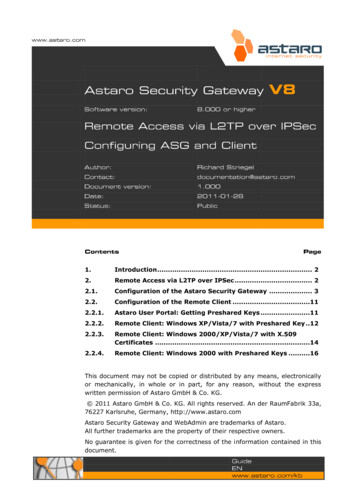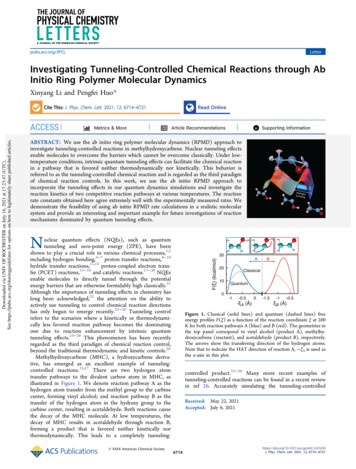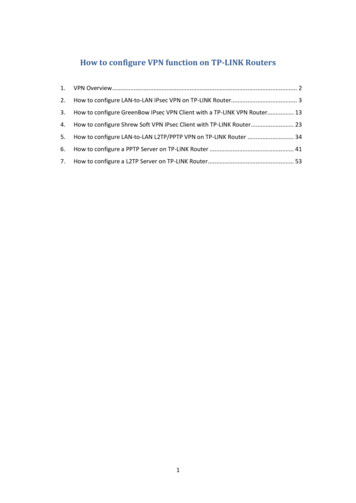
Transcription
CHAPTER14GRE Tunneling over IPsecGeneric routing encapsulation (GRE) tunnels have been around for quite some time. GRE wasfirst developed by Cisco as a means to carry other routed protocols across a predominantly IPnetwork. Some network administrators tried to reduce the administrative overhead in the coreof their networks by removing all protocols except IP as a transport. As such, non-IP protocolssuch as IPX and AppleTalk were tunneled through the IP core via GRE.GRE adds a new GRE header to the existing packet. This concept is similar to IPsec tunnelmode. The original packet is carried through the IP network, and only the new outer header isused for forwarding. Once the GRE packet reaches the end of the GRE tunnel, the externalheader is removed, and the internal packet is again exposed.Today, multiprotocol networks have mostly disappeared. It is difficult to find traces of thevarious protocols that used to be abundant throughout enterprise and core infrastructures. In apure IP network, GRE was initially seen as a useless legacy protocol. But the growth of IPsecsaw a rebirth in the use of GRE in IP networks. This chapter talks about the use of GRE in anIPsec environment.“Do I Know This Already?” QuizThe purpose of the “Do I Know This Already?” quiz is to help you decide whether you reallyneed to read the entire chapter. If you already intend to read the entire chapter, you do notnecessarily need to answer these questions now.The 15-question quiz, derived from the major sections in the “Foundation Topics” portion of thechapter, helps you to determine how to spend your limited study time.Table 14-1 outlines the major topics discussed in this chapter and the “Do I Know ThisAlready?” quiz questions that correspond to those topics.
328Chapter 14: GRE Tunneling over IPsec“Do I Know This Already?” Foundation Topics Section-to-Question MappingTable 14-1Foundation Topics SectionQuestions Covered in This SectionGRE Characteristics1GRE Header2Basic GRE Configuration3Secure GRE Tunnels4–5Configure GRE over IPsec Using SDM6–15ScoreTotal ScoreCAUTION The goal of self-assessment is to gauge your mastery of the topics in this chapter.If you do not know the answer to a question or are only partially sure of the answer, you shouldmark this question wrong for purposes of self-assessment. Giving yourself credit for an answerthat you correctly guess skews your self-assessment results and might provide you with a falsesense of security.1.2.3.What is the minimum amount of additional header that GRE adds to a packet?a.16 bytesb.20 bytesc.24 bytesd.36 bytese.48 bytesWhich of the following are valid options in a GRE header (select all that apply)?a.GRE Header Lengthb.Checksum Presentc.Key Presentd.External Encryptione.ProtocolWhat is the purpose of a GRE tunnel interface?a.It is always the tunnel source interface.b.It is always the tunnel destination interface.c.It is where the protocol that travels through the tunnel is configured.d.It is the interface that maps to the physical tunnel port.e.It is not used today.
“Do I Know This Already?” Quiz4.5.6.7.8.329When IPSec transport mode is used, how many IP headers are found in the GRE over IPsecpacket?a.One—the original IP header is replicated when needed.b.Two—the original IP header and the GRE IP header.c.Two—the original IP header and the IPsec IP header.d.Three—the original IP header, the GRE IP header, and the IPsec IP header.e.Four—the original IP header, the GRE IP header, the IPsec IP header, and the outer IPheader.What feature does GRE introduce that cannot be accomplished with normal IPsec?a.GRE increases the packet size so that the minimum packet size is easily met.b.GRE adds robust encryption to protect the inner packet.c.GRE requires packet sequencing so that out-of-order packets can be reassembledcorrectly.d.GRE adds an additional IP header to further confuse packet-snooping devices.e.GRE permits dynamic routing between end sites.What are the basic components within the Secure GRE Wizard (select all that apply)?a.Router interface configurationb.GRE tunnel configurationc.IPsec parameters configurationd.Router authentication configuratione.Routing protocols configurationWhat is the IP address inside of the GRE tunnel used for?a.The GRE tunnel peering point.b.The IPsec tunnel peering point.c.The routing protocols peering point.d.The management interface of the router.e.There is no IP address inside of the GRE tunnel.Which option must be configured if a backup secure GRE tunnel is configured?a.Source interfaceb.Source IP addressc.Destination interfaced.Destination IP addresse.Destination router name
330Chapter 14: GRE Tunneling over IPsec9.10.11.12.13.What methods are available for VPN authentication when used with a GRE tunnel (select allthat apply)?a.Digital certificatesb.Pre-shared keysc.Biometricsd.OTPe.KMAWhen creating/selecting an IKE proposal, what does the Priority number indicate?a.The Priority number is a sequence number.b.The Priority number determines the encryption algorithm.c.The Priority number helps determine the authentication method.d.The Priority number is related to the Diffie-Hellman group.e.The Priority number is necessary to select the hash algorithm.How are IPsec transform sets used in the Secure GRE Wizard?a.There must be a unique IPsec transform set for each VPN peer.b.There must be a unique IPsec transform set for each GRE tunnel.c.The two ends of a VPN must use the same IPsec transform set.d.The same IPsec transform set can be used for all VPN peers.e.Site-to-site IPsec VPN transform sets cannot be used for GRE over IPsec VPNs.Which dynamic routing protocols can be configured in the GRE over IPsec tunnel (select allthat apply)?a.RIPb.OSPFc.EIGRPd.BGPe.StaticWhich routing options are appropriate when using both a primary and a backup GRE tunnel(select all that apply)?a.RIPb.OSPFc.EIGRPd.BGPe.Static
“Do I Know This Already?” Quiz14.15.331When using OSPF in the GRE over IPsec tunnel, what OSPF parameters must match so thatthe two peers establish an OSPF adjacency (select all that apply)?a.IP address of the GRE tunnel interfaceb.Subnet of the GRE tunnel interfacec.OSPF area of the GRE tunnel interfaced.OSPF process ID of each routere.Number of networks configured in OSPF on each routerIn the Summary of the Configuration window, how can the displayed configuration bemodified?a.Type changes directly into the scroll window and click the Apply button at the bottomof the window.b.Changes cannot be made from within any wizard.c.Click the Modify button to return to the configuration windows.d.Click the Back button to return to the configuration windows.e.Click the Next button to proceed to the Modify Configuration window.The answers to the “Do I Know This Already?” quiz are found in Appendix A, “Answers to the‘Do I Know This Already?’ Quizzes and Q&A Sections.” The suggested choices for your next stepare as follows: 10 or fewer overall score—Read the entire chapter. This includes the “Foundation Topics,”“Foundation Summary,” and “Q&A” sections. 11 or 13 overall score—Begin with the “Foundation Summary” section, and then go to the“Q&A” section. 14 or more overall score—If you want more review on these topics, skip to the “FoundationSummary” section, and then go to the “Q&A” section. Otherwise, move to the next chapter.
332Chapter 14: GRE Tunneling over IPsecFoundation TopicsGRE CharacteristicsThe initial power of GRE was that anything could be encapsulated into it. The primary use of GREwas to carry non-IP packets through an IP network; however, GRE was also used to carry IPpackets through an IP cloud. Used this way, the original IP header is buried inside of the GREheader and hidden from prying eyes. The generic characteristics of a GRE tunnel are as follows: A GRE tunnel is similar to an IPsec tunnel because the original packet is wrapped inside ofan outer shell. GRE is stateless, and offers no flow control mechanisms. GRE adds at least 24 bytes of overhead, including the new 20-byte IP header. GRE is multiprotocol and can tunnel any OSI Layer 3 protocol. GRE permits routing protocols to travel through the tunnel. GRE was needed to carry IP multicast traffic until Cisco IOS Software Release 12.4(4)T. GRE has relatively weak security features.The GRE tunnel itself is similar to an IPsec tunnel. The tunnel has two endpoints. Traffic entersone end of the tunnel and exits the other end. While in the tunnel, routers use the new outer headeronly to forward the packets.The GRE tunnel is stateless. Unlike an IPsec tunnel, the endpoints do not coordinate anyparameters before sending traffic through the tunnel. As long as the tunnel destination is routable,traffic can flow through it. Also, by default, GRE provides no reliability or sequencing. Suchfeatures are typically handled by upper-layer protocols.GRE tunnels offer minimal security, whereas IPsec offers security by means of confidentiality,data authentication, and integrity assurance. GRE has a basic encryption mechanism, but the keyis carried along with the packet, which somewhat defeats the purpose.GRE does add an additional 24-byte header of overhead. This overhead contains a new 20-byte IPheader, which indicates the source and destination IP addresses of the GRE tunnel. The remaining4 bytes are the GRE header itself. Additional GRE options can increase the GRE header by up toanother 12 bytes.
GRE Header333It is important to note that the larger packet size caused by the additional headers can have adetrimental effect on network performance. Because the additional headers are dynamicallyadded, most users believe that nothing “bad” can happen as a result. If a packet is larger than theinterface maximum transmission unit (MTU) permits, the router must fragment the packet intosmaller pieces to fit. This fragmentation effort can add significant CPU overhead to a router, whichcan affect all packet forwarding.GRE is a simple yet powerful tunneling tool. It can tunnel any OSI Layer 3 protocol over IP. Assuch, it is basically a point-to-point private connection. A private connection between twoendpoints is the basic definition of a VPN.Unlike IPsec, GRE permits routing protocols (such as OSPF and EIGRP) across the connection.This is not the case with typical IPsec tunnels. IPsec tunnels can send IP packets, but not routingprotocols. Before the IP packets can travel through the IPsec tunnel, however, static routes arenecessary on each IPsec endpoint for routing awareness of the opposite end. This additionalconfiguration overhead does not scale well with a large number of IPsec tunnels.Until Cisco IOS Software Release 12.4(4)T, IP multicast had to be sent over GRE. Prior to thisIOS release, IPsec could not carry IP multicast traffic. Even though IOS 12.4(4)T now supports IPmulticast traffic, GRE over IPsec still must be used to carry dynamic routing protocols.GRE does not have any strong security features. The header provides an optional, albeit weak,security key mechanism. As a result, no strong confidentiality, data source authentication, or dataintegrity mechanisms exist in GRE. However, IPsec provides confidentiality (DES, 3DES, orAES), and source authentication and data integrity with MD5 or SHA-1 HMACs.Thus, a GRE tunnel, which carries multicast and routing traffic, can be sent through an IPsectunnel for enhanced security.GRE HeaderThe GRE header itself contains 4 bytes, which represent the minimum size of GRE header withno added options. The first pair of bytes (bits 0 through 15) contains the flags that indicate thepresence of GRE options. Such options, if active, add additional overhead to the GRE header. Thesecond pair of bytes is the protocol field and indicates the type of data that is carried in the GREtunnel. Table 14-2 describes the GRE header options.
334Chapter 14: GRE Tunneling over IPsecGRE Header OptionsTable 14-2GRE Header BitOptionDescription0Checksum PresentAdds a 4-byte checksum field to the GRE header after theprotocol field if this bit is set to 1.2Key PresentAdds a 4-byte encryption key to the GRE header after thechecksum field if this bit is set to 1.3Sequence NumberPresentAdds a 4-byte sequence number to the GRE header after thekey field if this bit is set to 1.13–15GRE Version0 indicates basic GRE, while 1 is used for PPTP.The Checksum Present option (bit 0) adds an optional 4-byte checksum field to the GRE header.This checksum appears after the protocol field in the GRE header only if the Checksum Presentbit is set. Normally, this option is not needed because other upper-layer protocols providechecksum capabilities to detect packet corruption.The Key Present option (bit 2) adds an optional 4-byte key field to the GRE header. This clear-textkey follows the checksum field. The key is used to provide basic authentication where each GREendpoint has the key. However, the key itself is exposed in the GRE header. Due to thisvulnerability, GRE encryption is not typically used. However, the key value can be used touniquely identify multiple tunnels between two endpoints. This would be similar to an IPsec SPI.The Sequence Number option (bit 3) adds an optional 4-byte sequence number field to the GREheader. This sequence value follows the key option. This option is used to properly sequence GREpackets upon arrival. Similar to the checksum option, this is not typically used because upper-layerprotocols also offer this functionality.Bits 13–15 indicate the GRE version number. 0 represents basic GRE, while 1 shows that thePoint-to-Point Tunneling Protocol (PPTP) is used. PPTP is not covered in this book.The second 2 bytes of the GRE header represent the Protocol field. These 16 bits identify the typeof packet that is carried inside the GRE tunnel. Ethertype 0x0800 indicates IP. Figure 14-1 showsa GRE packet with all options present added to an IP header and data.
Basic GRE ConfigurationFigure 14-1335GRE Packet Format20 bytes2 bytes2 bytesTunnel IPHeaderGRE FlagsProtocol TypeIP HeaderRequired GRE HeaderTransportHeaderDataOriginal IP Header and PacketOptional GRE HeaderChecksumOffset4 bytesKeySequenceNumber4 bytes4 bytesIn Figure 14-1, only the required GRE header and original IP header and packet typically appearin GRE tunnel configurations. The GRE options are normally not used because upper-layerprotocols provide similar functionality.Basic GRE ConfigurationA GRE tunnel carries some Layer 3 protocol between two IP endpoints. During the initial use ofGRE tunnels, the tunnel contents were typically any protocol except IP. Today, GRE tunnels areused to carry IP data over an IP network. But the GRE tunnel itself can be sent through an IPsectunnel for security. Figure 14-2 shows a basic GRE tunnel setup.Figure 14-2GRE Tunnel ConfigurationS2/1: 172.16.1.2S3/2: 10.1.3.2Remote OfficeCentral OfficeInternet192.168.1.0/24192.168.101.0/24GRE TunnelRouter ARouter B192.168.2.0/24192.168.102.0/24interface serial 2/1ip address 172.16.1.2 255.255.255.0interface tunnel 0ip address 192.168.200.1 255.255.255.0tunnel source serial 2/1tunnel destination 10.1.3.2tunnel mode gre ipinterface serial 3/2ip address 10.1.3.2 255.255.255.0interface tunnel 2ip addr 192.168.200.2 255.255.255.0tunnel source serial 3/2tunnel destination 172.16.1.2tunnel mode gre ip
336Chapter 14: GRE Tunneling over IPsecThe basic configuration components of a GRE tunnel include A tunnel source (an interface or IP address local to this router) A tunnel destination (an IP address of a remote router) A tunnel mode (GRE/IP is the default) Tunnel traffic (data that travels through the tunnel, and is encapsulated by the GRE header)In Figure 14-2, two IP endpoints have a GRE tunnel configured between them. The GRE tunnel isactually defined as an interface in each router. The GRE interface is what makes GREmultiprotocol. IPsec crypto maps can match only IP access lists. A router interface can beconfigured for, and thus transport, any protocol. The available protocols are dependent upon theCisco IOS feature set installed.TIP The Cisco Software Advisor do)helps select the appropriate IOS feature set for any given Cisco router platform.The tunnel source and destination are IP interfaces. Thus, the GRE travels across an IP network.The protocol configured on the GRE interfaces is the data that travels through the GRE tunnel.The GRE tunnel source on one end must match the destination on the other end, and vice versa.This IP validation is performed as the GRE tunnel is established. For proper routing through theGRE tunnel, a common subnet should be configured within the tunnel.In Figure 14-2, IP is configured within the GRE tunnel. The two sites, as well as the tunnel itself,use RFC 1918 private addressing. IP routing flows between the sites through the GRE tunnel bymeans of your favorite routing protocol (not shown). For documentation purposes, the publicnetwork also uses private addressing, although this certainly is not a requirement.Secure GRE Tunnels“GRE over IPsec” implies that the GRE packet sits higher in the stack than the IPsec portion.Similar to how TCP/IP is represented, TCP is at Layer 4, while IP is at Layer 3. When laid out ina graphical packet, the TCP portion is inside of the IP part. The same is true with GRE over IPsec.The original packet is the innermost layer. Then the GRE wrapper appears. Finally, the IPsecportion is added for security. Figure 14-3 shows the GRE over IPsec packet format.
Secure GRE TunnelsFigure 14-3337GRE over IPsec Packet FormatTunnel ModeESP IPHeaderESPHeaderGRE erDataESPTrailerESPTrailerTransport ModeGRE IPHeaderESPHeaderAs Figure 14-3 shows, there are multiple IP layers in a GRE over IPsec packet. The innermostlayer is the original IP packet. This represents data that is traveling between two devices, or twosites. The initial IP packet is wrapped in a GRE header to permit routing protocols to travelbetween in the GRE tunnel (something that IPsec alone cannot do). And IPsec is added as the outerlayer to provide confidentiality and integrity (which is a shortcoming of GRE by itself). The endresult is that two sites can securely exchange routing information and IP packets.Figure 14-3 is also a reminder of the two IPsec modes: tunnel and transport. Transport mode isused if the original IP header can be exposed, while tunnel mode protects the original IP headerwithin a new IPsec IP header. When using GRE over IPsec, transport mode is often sufficient,because the GRE and IPsec endpoints are often the same. Whether tunnel or transport mode isselected, the original IP header and packet are fully protected.What might get lost in Figure 14-3 is the size of the new packets created due to the additionalencapsulations. Each IP header adds 20 bytes to the packet size. This does not include overheadfor ESP and GRE headers. For small IP packets, it is possible that the GRE over IPsec headersmay be much larger than the original packet itself. Network efficiency can be determined by theratio of actual data compared to the overhead associated with transporting the data. When there ismore overhead (packet headers) than actual data, then the network is inherently less efficient.Most GRE over IPsec implementations use a hub-and-spoke design. Although not a requirement,such a design minimizes the management overhead seen with managing a large number of IPsectunnels. For example, if ten sites were fully meshed with GRE over IPsec tunnels, it would take45 tunnels ([10 * 9]/2). In a hub-and-spoke design, full connectivity (via the hub) is accomplishedwith only nine tunnels. Figure 14-4 graphically compares a full mesh of tunnels versus a hub-andspoke design.
338Chapter 14: GRE Tunneling over IPsecFigure 14-4Full Mesh versus Hub-and-SpokeFull MeshHub and SpokeIn a normal IPsec tunnel, static routes are needed to direct IP packets into the IPsec VPN tunnel.Routing protocols can run inside the GRE tunnel, creating a dynamic routing topology. GREprovides the routing connectivity, while IPsec provides the confidentiality and integrity. WithGRE, routing protocols can now run inside the IPsec tunnel.
Configure GRE over IPsec Using SDM339Configure GRE over IPsec Using SDMThis chapter explores how to configure GRE over IPsec using the SDM tool. The previous chaptergave you the opportunity to create an IPsec tunnel in SDM, and get familiar with the SDMinterface. This section expands upon previous navigation skills that you have learned.Launch the GRE over IPsec WizardThe GRE over IPsec wizard is accessed from the same window that started the Site-to-Site VPNwizard as seen in Chapter 13. Figure 14-5 shows how to access the GRE over IPsec wizard.Figure 14-5GRE over IPsec WizardSimilar to how the Site-to-Site VPN Wizard was initiated in Chapter 13, the GRE over IPsecwizard is accessed as follows:Step 1Click the Configure button at the top of the window.Step 2Click the VPN button in the Tasks bar on the left.Step 3Click the Site-to-Site VPN option at the top of the menu.Step 4Click the Create Site to Site VPN tab in the window.Step 5Click the Create a secure GRE tunnel (GRE over IPSec) radio button.Step 6Click the Launch the selected task button at the bottom of the window.
340Chapter 14: GRE Tunneling over IPsecWhen you successfully accomplish these tasks, the Secure GRE Wizard starts. The Secure GRETunnel (GRE over IPsec) window reminds you of the capabilities and purpose of such a tunnel.The basic steps of the Secure GRE Wizard are as follows:Step 1Create the GRE tunnel.Step 2Create a backup GRE tunnel (optional).Step 3Select the IPsec VPN authentication method.Step 4Select the IPsec VPN IKE proposals.Step 5Select the IPsec VPN transform sets.Step 6Select the routing method for the GRE over IPsec tunnel.Step 7Validate the GRE over IPsec configuration.To continue into the wizard, click Next at the bottom of the window.Step 1: Create the GRE TunnelThe first part of the GRE over IPsec tunnel is the GRE tunnel. Figure 14-3 showed the variouslayers within the GRE over IPsec tunnel. The original IP packet is the innermost portion. Nextcomes the GRE layer. Figure 14-6 shows the GRE Tunnel Information window.Figure 14-6GRE Tunnel Information
Configure GRE over IPsec Using SDM341The GRE Tunnel Information window is the first configuration window of the Secure GREWizard. There are two sets of IP addresses that are applied to the GRE tunnel interface—the tunnelsource and destination (at the top of the window) represent the GRE IP header (shown in Figure14-3).The tunnel source is either selected from a pull-down list of interfaces in this router or enteredmanually. If an interface is selected from the list, the IP address of the interface is automaticallyused as the GRE tunnel source. The tunnel destination is the IP address of the remote GRE peerand must be manually entered.The IP address of the GRE tunnel is the IP subnet used within the tunnel itself. This subnet can beused for management (the other end can be pinged) or, more importantly, for routing protocolneighbors. The remote GRE peer must use a unique IP address on the same inner subnet.Path MTU is enabled by default. Remember that GRE over IPsec considerably increases the IPpacket size. Path MTU discovery uses Internet Control Message Protocol (ICMP) Unreachablemessages to determine the maximum packet size possible between the GRE peers. If needed,fragmentation can then be performed by the GRE endpoints, versus en route, where it might notbe performed at all.When you are finished with the GRE Tunnel Information window, click Next at the bottom ofthe window.Step 2: Create a Backup GRE TunnelThe Secure GRE Wizard offers the option to create a second GRE tunnel for survivability. If theGRE tunnel fails for any reason, then the IPsec tunnel that is carried within it fails also. A backupGRE tunnel provides stateless failover in the event of the loss of the primary GRE tunnel. Figure14-7 shows the Backup GRE Tunnel Information window.Because a backup GRE tunnel is an optional feature, you must check the Create a backup secureGRE tunnel for resilience box to activate this window. Once checked, the configuration optionsare very similar to those used to create the primary GRE tunnel.The same tunnel source is used for both the primary and backup GRE tunnels, so there is noopportunity to select a tunnel source in the Backup window. Either an interface or a local IPaddress was entered earlier for the primary GRE tunnel. Simply enter the IP address of thealternate peer for this backup GRE tunnel. This IP address could be a different interface on thesame peer router, or an entirely different device at the remote site.
342Chapter 14: GRE Tunneling over IPsecFigure 14-7Backup GRE Tunnel InformationSimilar to the primary GRE tunnel, you must create a unique IP address on a new IP subnet withinthis backup tunnel. The remote peer must use the same subnet with an exclusive IP address of itsown. As with the primary GRE tunnel, the inner IP addresses are used to establish routing protocolneighbors.When you are finished with the Backup GRE Tunnel Information window, click Next at thebottom of the window.Steps 3–5: IPsec VPN InformationThe outermost layer of the GRE over IPsec tunnel is the IPsec VPN. The various windows used toenter the IPsec information are nearly identical to those used to create a site-to-site IPsec VPNdiscussed in Chapter 13, “Site-to-Site VPN Operations.”The first IPsec VPN task is to enter the VPN authentication information. Similar to Figure 13-14,either digital certificates or pre-shared keys can be used. If pre-shared keys are selected, the keymust be entered twice to ensure accuracy.The second IPsec VPN task is to select or create IKE proposals. This window is identical to theone shown in Figure 13-15, as are the procedures used to select an appropriate IKE proposal forthis IPsec VPN. Remember that the remote IPsec peer must have an identical IKE proposalconfigured, and that the same IKE proposal can be used for many remote peers.
Configure GRE over IPsec Using SDM343The third IPsec VPN task is to select or create IPsec transform sets. This window is identical tothe one shown in Figure 13-16. From here, new transform sets can be created, and the appropriatetransform set can be selected for use with this IPsec VPN. Remember that the remote IPsec peermust have an identical IPSec transform set configured, and that the same IPsec transform set canbe used for many remote peers.Step 6: Routing InformationOnce both the GRE tunnel and the IPsec tunnels have been configured, the final step is to select arouting protocol to traverse the GRE tunnel. Remember that with a typical IPsec VPN, the onlyrouting option is to configure static routes on each side. These static routes manually determinewhich prefixes are reachable through the IPsec VPN. Figure 14-8 shows the Select RoutingProtocol window of the Secure GRE Wizard.Figure 14-8Select Routing ProtocolStatic Routing is the default option (radio button) in the routing protocol selection process. Thereare four routing options supported within the GRE tunnel: EIGRP OSPF RIP Static routing
344Chapter 14: GRE Tunneling over IPsecEach routing option uses the Routing Information window to configure individual options. Routesthat are manually configured (static) or dynamically exchanged (RIP, OSPF, or EIGRP) throughthe GRE over IPsec tunnel become the “interesting traffic” described that decides which traffic isencrypted through the IPsec tunnel. Once you have selected a routing protocol, click Next at thebottom of the window to proceed to the Routing Information window for the appropriate routingprotocol.When using the GRE over IPsec wizard, RIP is not an available dynamic routing option from theSelect Routing Protocol window if a backup GRE tunnel was configured earlier. Only OSPF orEIGRP can be enabled when two GRE tunnels to the same remote location are used.Static RoutesStatic routing is typically used to support small stub sites that only have a single subnet. Nodynamic routing information is exchanged between sites. If a site has multiple subnets that are touse the VPN, or if a site uses backup VPN tunnels, then static routing is inappropriate.If static routing is selected in the Select Routing Protocol window of the wizard, the first choicepresented is whether to do split tunneling or not. Split tunneling allows the router to send sometraffic through the IPsec VPN to the remote side, and the remainder of the traffic unprotected intothe public network. This is very similar to the definition of interesting traffic with IPsec VPNs.Enter an IP subnet and subnet mask that is to be protected in the VPN tunnel.The wizard permits only a single static route to be configured within the split tunneling option. Ifsplit tunneling is not selected (the Tunnel All Traffic option), then a default route is added to therouter that sends all traffic through the GRE over IPsec tunnel.When you are finished with the static routing options, click Next at the bottom of the window toadvance to the Summary of the Configuration window.RIPThe first RIP configuration option is the version. Select version 1 to use the older classful versionof RIP, or version 2 for the more modern classless version that sends the subnet mask with therouting updates. Next, click the Add. button local networks to the RIP routing protocol.Remember that you can add only whole classful network numbers to RIP, and all subnets of thatnetwork number are included. You must add the IP subnet of the GRE interface for RIP to use theinterface.Routes that are not added to the RIP configuration are not exchanged through the GRE over IPsectunnel. Only traffic in the exchanged routes is protected by the VPN. Traffic outside of the RIP
Configure GRE over IPsec Using SDM345routes avoids the VPN. It is important that the remote router also correctly c
GRE increases the packet size so that the minimum packet size is easily met. b. GRE adds robust encryption to protect the inner packet. c. GRE requires packet sequencing so that out-of-order packets can be reassembled correctly. d. GRE adds an additional IP header to further confuse packet-snooping devices. e. GRE permits dynamic routing .










